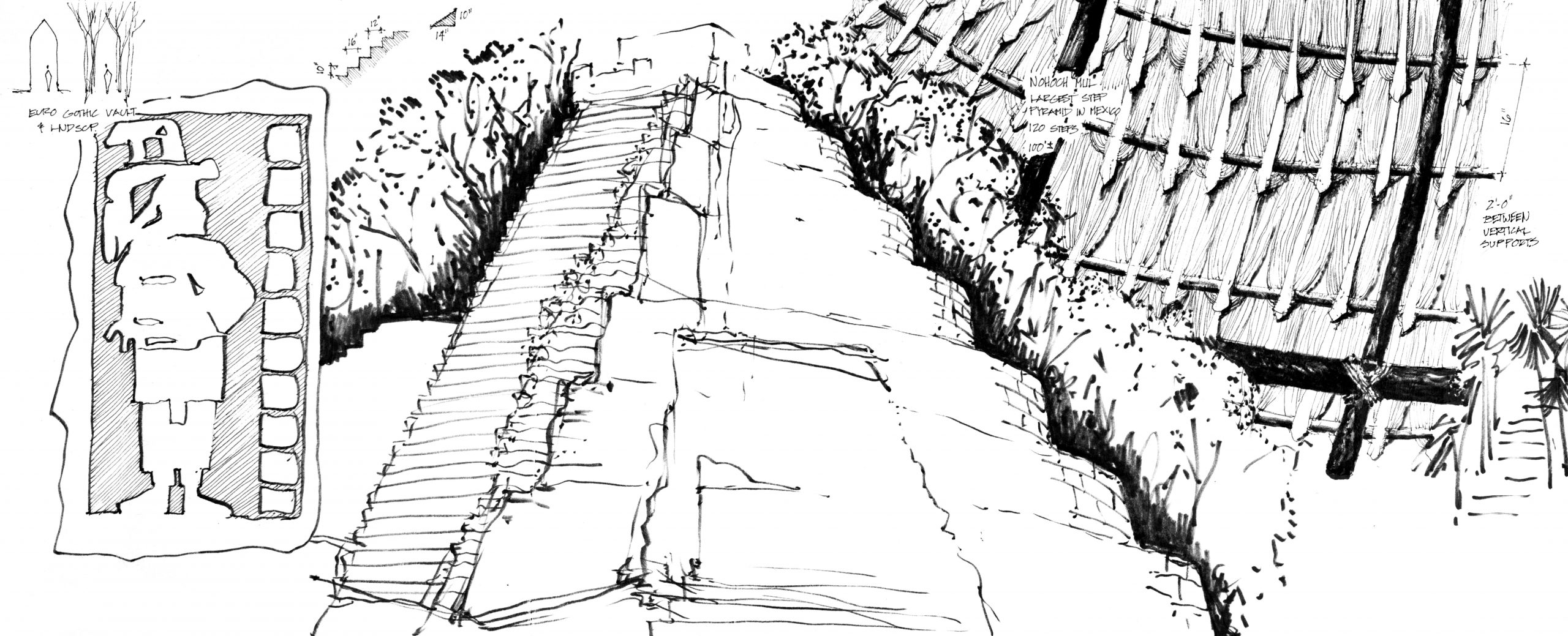8.8.Mexico-2-detail-b Mayans – Highlights Relevant to Sustainable Design:
See the influence of your immediate world (continued) from 8.7 Mexico-2-detail-a https://learnfromlooking.com/mexico/ancient-ruins-yukatan/
I do not believe that it is unrealistic to think that the Mayan people a thousand years ago, or the Europeans several hundred years ago, mimicked their natural environment. The gothic style pointed arches of great cathedrals and the stained-glass windows convey the feeling of light coming through the woods as you walk down the nave. The Europeans carved biblical stories in stone at various palaces in their religious buildings to teach the people, who in many cases did not have the ability to read. The Mayans carved “glyphs” in their buildings, which like the European carvings told stories, as did the Egyptians with their hieroglyphs.
Without access to see other countries via sea or air travel, let alone print publications, TV, or the Internet, the Mayans did not have a reference as inspiration to build structures that were tall and thin. They created with their own means a form of architecture based on the natural world around them. They did not have the materials and technology at the time to build lean structures, so this observation is more about intent than capacity.
In the twenty-first century, “lean” has become a term for efficiency, used initially by the Massachusetts Institute of Technology (MIT) following studies of Japanese manufacturing processes. Perhaps in the 1970s, we were manufacturing cars in the United States based on what we knew at the time and not the levels of quality assurance and automation that were deployed half a world away. If we look beyond our immediate frame of reference, then we can question what we do and how we do it to decide if there is a different path for consideration.
The gas-guzzling cars of the seventies are largely now extinct, and Detroit had to file bankruptcy. The city became in many ways a ruin. We have the fortitude and savvy to build it back, but we let it slip away in part because we were more inwardly focused than externally conscious. The definition of insanity is doing the same thing over and over and expecting a different result. For too long, we repeated the production of inefficient cars that also did not have the quality assurance and as much reliability as the Japanese imports at that time. We were building cars that were unsustainable, and that led to the economy of a whole city that became unsustainable.
8.9.Mexico-2-detail-c Mayans


Closing Perspective on the Mayan Experience
The word “old” is relative to the specific elements of comparison. The Mayan ruins are certainly old relative to all of the architecture in the United States since the founding of the country and most of the standing architecture in Europe, Asia, and around the world. The adage “With age comes wisdom” inspires me to think that the old Mayan ruins have a wise story to tell. Sometimes we just need to pause to look and extract some information from the awesome silence of the millennia.
The wisdom of the ruins may come in the form of lessons in restraint. The successful growth of the Mayan culture and the resulting population increases at urban centers may have contributed to their demise. By clearing so much vegetation to expand their cities and suburbs two thousand years ago, they were the first major “sprawl” culture. Their system became unsustainable with a ripple effect: less vegetation, amplified flood damage, increased water contamination, more disease, and death. They simply did not manage their growth. Across the nations of the world, we have doubled our global population in just the last forty years. Sprawl has often replaced regional farming or woodlands, and fresh drinking water is a commodity that we should not take for granted. We have the means to manage our growth sustainably, and looking back often helps guide the path forward.
8.10.Mexico-2-detail-d Mayans

Author and illustrator: Charlie Szoradi is an architect, inventor, and the CEO of Independence LED Lighting. He writes about many other topics related to Mayans through his extensive travels around the world.
If you have found this posting online, it is an excerpt from Mr. Szoradi’s book Learn from Looking that served as the inspiring seed content for this drawing share resource. For additional drawings and insights on Mayans and their culture, we hope that you enjoy exploring LearnfromLooking.com. You can search via general terms such as sustainability as well as narrower terms such as Mayans and Mayan ruins.



